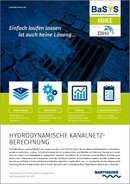Hydrodynamic sewer network calculation
With BaSYS, the hydraulic capacity of the sewer network can be verified using the integrated hydrodynamic simulation process. Intuitive technical data forms provide detailed views and tables for data collection and the planning and administration of source and hydraulic data. Hydraulic variants support the design of different execution versions without changing the source data. Thanks to the technical data forms and interactive graphics, the calculation results can be easily verified in a variety of ways. General default data including sewer profiles, precipitation models and catchment area characteristics are stored in individually configurable libraries accessible across projects.
Hydrodynamic Sewer network simulation in MIKE1D
The hydrodynamic calculation program uses the MIKE1D calculation engine from DHI for the simulation. The Saint-Venant equations underlying the hydrodynamic sewer network simulation are also solved for the following boundary conditions:
- Lowering curves at drops and for slope changes
- Losses of momentum due to cross-section and direction changes
- Retention including hydraulic losses in structures and manholes, especially in water rings and for discharge under sluices
- Storage in structures and manholes, also based on volume curves
- Working ranges of speed-controlled pumps between boundary curves
The curve library supports the standardised and scalable specification of volume, pump, flow and throttle curves.
Hydraulic modelling
The sewer objects of the hydraulic network can be calculated directly from the database without changing the source data through hydraulic standby systems. For each calculation run, the hydrodynamic sewer network simulation takes into account all calculation elements such as pipes, open ditches, retaining basins, junctions, special structures, weirs, pumps and slide valves/throttles. Global pre-settings permit the parallel formulation and administration of various boundary conditions for the hydrodynamic simulation of the sewer network. Individual hydraulic conditions that deviate from the default settings can also be defined per sewer object. Rain from the rain type library is assigned to each calculation run.
Visualisation of the results
Predefined database queries and reports are available for visualising the results of the hydrodynamic sewer network simulation. A statistical analysis of the results is performed with the BaSYS Dashboard, with the option of interactive filtering. Thus the current project status is interactively presented to decision makers. Hydrographs are generated for all calculated sewer objects and stored in the database by the calculation runs of the hydrodynamic sewer network simulation. In the forms, hydrograph values (flow, water level, overflow volume) are shown graphically and in table form, the extreme values in table form and fields. In BaSYS-Plan the data are visualised with theme plans, for example regarding the water level and hydraulic utilisation. An overview of results also shows the hydrographs for the active sewer object and the adjacent objects.
Dynamic longitudinal section
The dynamic longitudinal section corresponds to a video animation of the development of the water level situation over time in a chosen sequence of sewer segments. Thus the simulation results for critical sections of the sewer network can be realistically visualised. The animation is carried out automatically and/or with a manual slider. Interrupting the animation, stopping the slider or navigating directly to a time step produces a freeze frame that can be printed and/or exported.
Benefits and advantages
- Simplified numeric solving of the Saint-Venant equations for short pipe lengths and automated optimisation of the iteration intervals to avoid instabilities.
- Consideration of backup, the compound effect of interconnected networks, retention, complex hydraulic boundary conditions and possible flow direction changes.
- Direct simulation of all network elements (pipes, pressure pipes, ditches, retaining capacities, junctions, special structures, slide valves/throttles) without changing the source data through hydraulic standby systems. Planning the connections, weirs, pumps and slide valves/throttles using the building block principle with a virtually unlimited number of those elements.
- Use of the BaSYS Arena architecture with numerous possibilities for fast searching, comparison, verification of plausibility, structured adaptation and output of the relevant data.
- Graphical output of the precipitation data, profile cross-sections, hydrographs and curves. Comparative hydrograph output for adjacent sewer segments and for structures with all sub-elements. Complete user-defined variable theme plans and dynamic longitudinal section of the calculation results.

